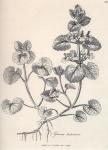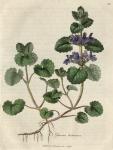
 Synonyma. Hedera terrestris. Pharm. Edin. Gerard. 856. Raii Hist. vol. 1. 567. Synop. 243.
Synonyma. Hedera terrestris. Pharm. Edin. Gerard. 856. Raii Hist. vol. 1. 567. Synop. 243.
Hedera terrestris vulgaris, Bauh. Pin. 306. Park. Theat. 679.
Chamaecissus sive Hedera terrestris. J. Bauh. vol. 3. 855.
Chamaeclema cause procumbente radicato, foliis reniformibus, rotunde crenatis. Hal. Stirp. Helv. No. 245.
Glecoma hederacea. With. Bot. Arrang. 603. Relhan Flor. Cant. 225. Curtis Flor. Lond. Flor. Dan. t. 789.
Class Class Didynamia. Ord. Gymnospermia. L. Gen. Plant. 714.
Ess. Gen. Ch. Antherarum singulum par in formam crucis connivens. Calyx 5-fidus.
Spec. Char. G. foliis reniformibus crenatis.
This plant has a small, perennial, creeping, fibrous root, which puts forth stalks from six inches to a foot and a half in height; these are square, procumbent, and at the knots or joints woolly; the leaves are of a roundish kidney-shape, scolloped, hairy, and stand in opposite pairs upon channelled footstalks; the flowers grow in verticilla, or whorls of three, four, or five together, on short peduncles, placed about the footstalks of the leaves j the calyx is tubular, permanent, striated, rough, and divides into five unequal pointed segments; the flower is blue, monopetalous, bilabiated, with a slender compressed tube; the upper lip is cleft, erect, blunt, the lower lip is expanded, large, divided into three lobes, of which the middle one is the largest, and is notched at the end; the bractaea are small, tapering, and grow from the peduncles; the filaments are four, two long and two short, covered by the upper lip, and the antherae of each pair approach so as to form a cross; the style is filiform, the stigma is bind, and pointed; the seeds are four, oval, naked, and lodged in the calyx. It is a well known plant, growing commonly under hedges, and flowering in April.
Ground-ivy has a peculiar strong smell, [Dr. Withering has observed, that the leaves are "beset underneath with hollow dots, in which are glands secreting an essential oil, and above with little eminences, but which do not secrete any odoriferous oil; for this surface being rubbed gives out no peculiar scent, whereas the under surface affords a pleasant reviving scent." l. c.] and its taste is bitterish, and somewhat aromatic. It is one of those plants which was formerly in considerable estimation, and supposed to possess great medicinal powers, but which later experience has been unable to discover; in proof of this, its name is omitted in the catalogue of the materia medica by the London College. The qualities of this plant have been described by different authors, as pectoral, detergent, aperient, diuretic, vulnerary, corroborant, errhine, &c.—and it has been variously recommended for the cure of those diseases to which these powers seemed mod adapted, but chiefly in pulmonary [Willis, Pharm. rat. sect. i. c. 6. Morton, Phthisiologia, lib. 3. Cap. 5. Sauvages Nosol. Tom. 3. P. 2. cap de phthisi. Ettmuller, Oper T. p. 639. Scardona Aphoris. lib. 2. p. 69. River. Prax. P. 1. p. 397. See also Ray, Gerard, Miller, and others.] and nephritic [Paulli Quadrip. bot. p. 74. Sennertus. Oper. T. 3. p. 576. Plater. Prax. Tom. 2. p. 499. Reusn. Observ. Med. p. 90. apud Welch. Mead Mon. et praec. med. p. 97.] complaints. In obstinate coughs it is a favourite remedy with the poor, who probably experience its good effects by still persevering in its use. Ray, Mead, and some others, speak of its being usefully joined with fermenting ale; [From the general use of Ground-ivy, mixed with ale, &c. it acquired the name of Ale-hoof and Tun-hoof.] but Dr. Cullen observes, "it appears to me frivolous. In short, in many cases where I have seen it employed, I have had no evidence either of its diuretic or of its pectoral effects. In common with many other of the verticillatae, it may be employed as an errhine, and in that way cure a head-ach, [Ray gives a remarkable instance of its efficacy in this way, in the case of Mr. Oldacres, and says, "Succus hujus plantae naribus attractus cephalalgiam etiam vehementissimam & inveteratam non lenit tantum sed & penitus aufert—Medicamentum hoc non satis potest laudari, si res ex usu aestimarentur, auro aequiparandum." l. c.] but no otherways by any specific quality." It is usually taken in the way of infusion, or drunk as tea.

